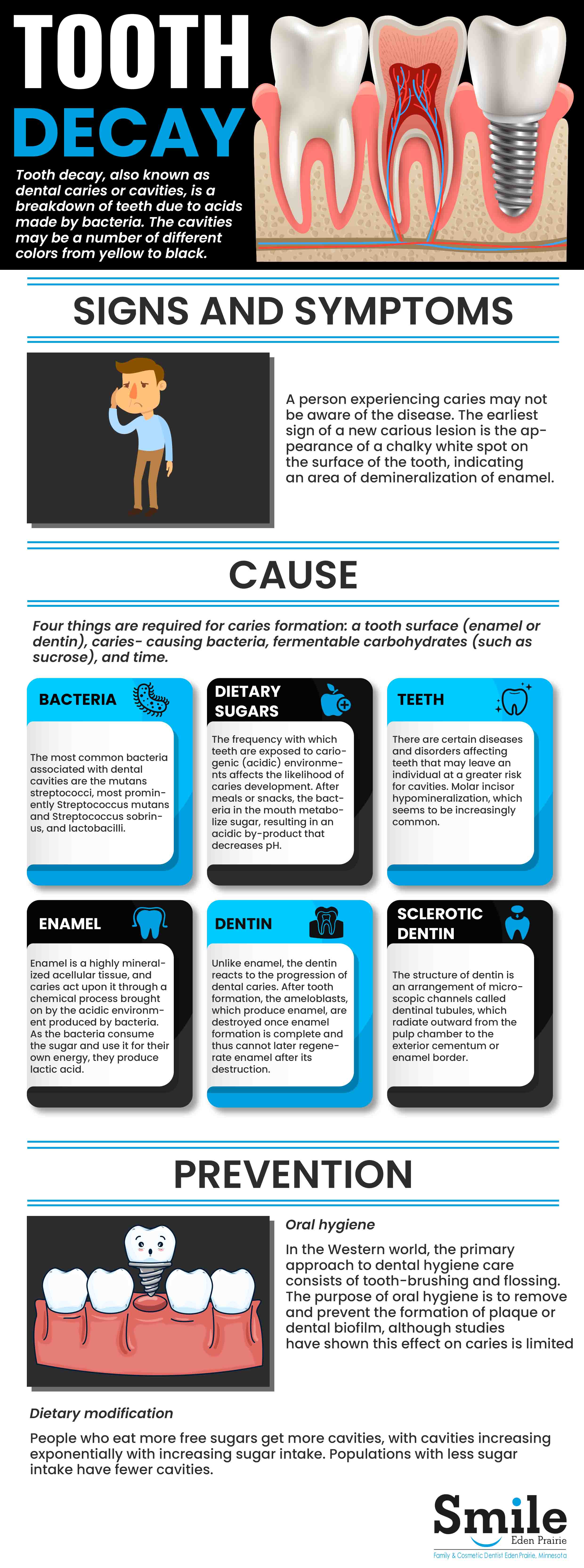General Dentistry Concepts: Dental cavities
Tooth decay is also known as dental caries or more commonly as cavities. Tooth decay is the breakdown of teeth as a result of acids from bacteria. Cavities can appear in various colors ranging from yellow to dark brown or black. Symptoms of cavities can include pain, sticking and difficulty with eating. Complications from the cavity can include gum inflammation around the tooth, tooth loss and infection or the formation of an abscess.
Cavities are caused when the acid from bacteria dissolves the hard tissues of the teeth. The hard tissues of the teeth include enamel, dentin and cementum. The acid is produced when bacteria breaks down sugar and food debris. Simple sugars are the main energy source for the bacteria. As a result, a diet which includes high amounts in simple sugars can be a risk factor. Caries or cavities are a result of the mineral breaking down at a faster rate than the build up from sources such as saliva. Some conditions which result in a lower production of saliva include: diabetes mellitus, Sjogren's syndrome and some medications. Medications that commonly lower the production of saliva include antihistamines and antidepressants. Caries are also often associated with poverty, poor oral health, inadequate access to dental care and receding gums which expose the roots of the teeth.
Regular and thorough cleaning of the teeth, flossing, a low-sugar diet and small amounts of fluoride can help prevent cavities. Brushing the teeth twice a day and flossing daily is recommended to maintain oral health at home. Early detection is critical in maintaining the tooth and avoiding an extraction. Various treatments can be used to restore the tooth from a cavity or the tooth may be completely removed.
Nearly half of the world’s population have dental caries in their permanent teeth. The World Health Organization (WHO) estimates that nearly all adults have dental caries. In baby teeth, amount 10% of the population is affected. Cavities have become more common in recent years.
Signs and symptoms
It is common for a person who has dental caries to be aware of the presence of the disease. Early signs of a new carious lesion includes the appearance of a chalky white spot on the tooth’s surface. As the lesion continues to demineralize, it turns to a brownish color and eventually into a cavity. The process is reversible before the cavity forms, however, once the cavity forms, the decayed tooth structure cannot be regenerated. A dark brown and shiny lesion suggests that a dental caries were once present, but the demineralization process has stopped. The process results in a stain. Active decay is a lighter color and more dull in appearance.
As the enamel and dentin are dissolved, the cavity is more noticeable. The decayed areas of the tooth change color and become soft. Once the decay passes through enamel, the dentinal tubules are exposed. The dentinal tubules connect to the nerve of the tooth, and are painful when exposed. The pain can be transient and worsen with exposure to heat, cold, or sweet foods and drinks. A weak tooth which has extensive internal decay can sometimes fracture unexpectedly with normal chewing. A toothache can be present when the decay has allowed the bacteria into the pulp tissue in the center of the tooth. The pain will also become more constant. Common consequences include death of the pulp tissue and infection. Once this occurs, the tooth is no longer be sensitive to hot or cold temperatures, but can be very sensitive to pressure.

